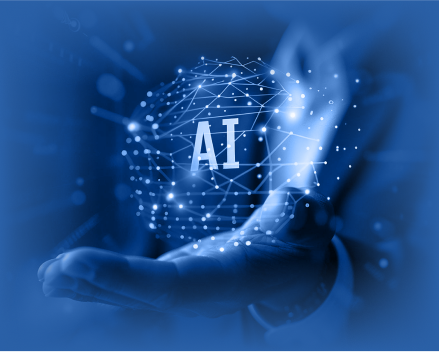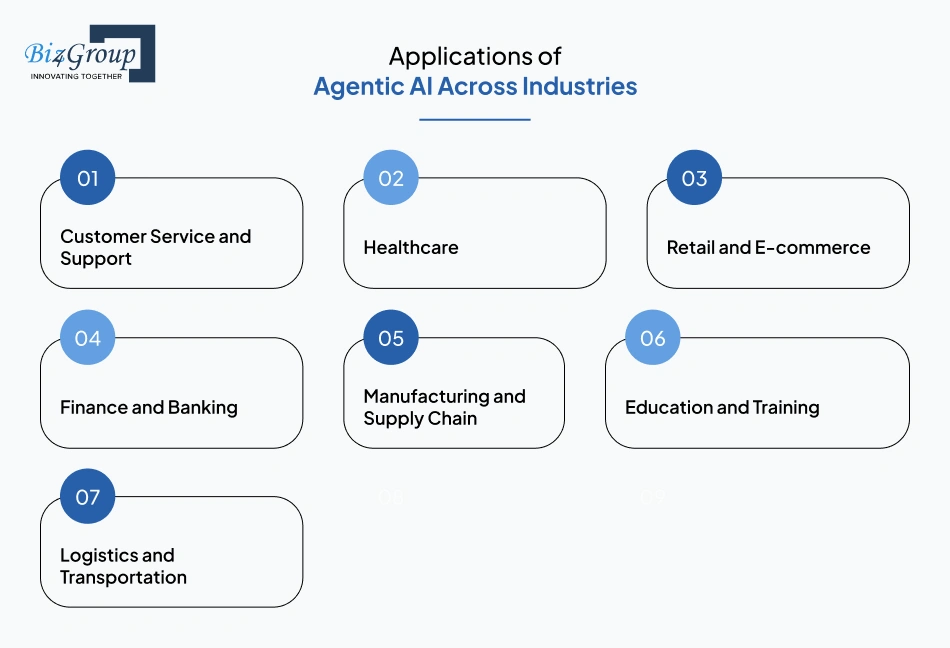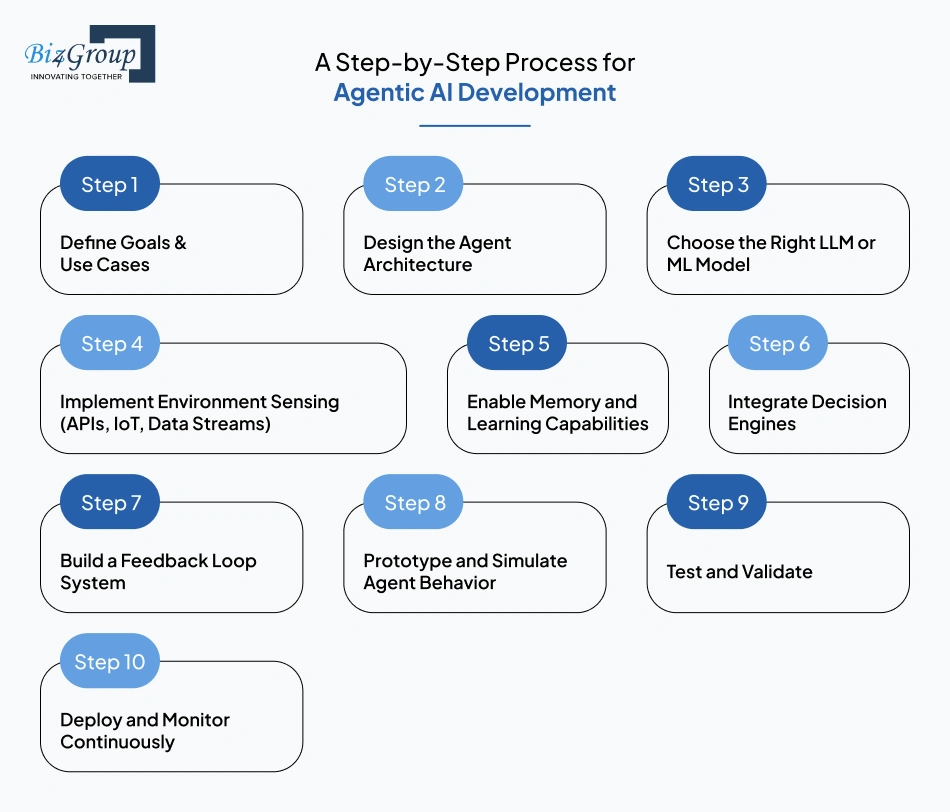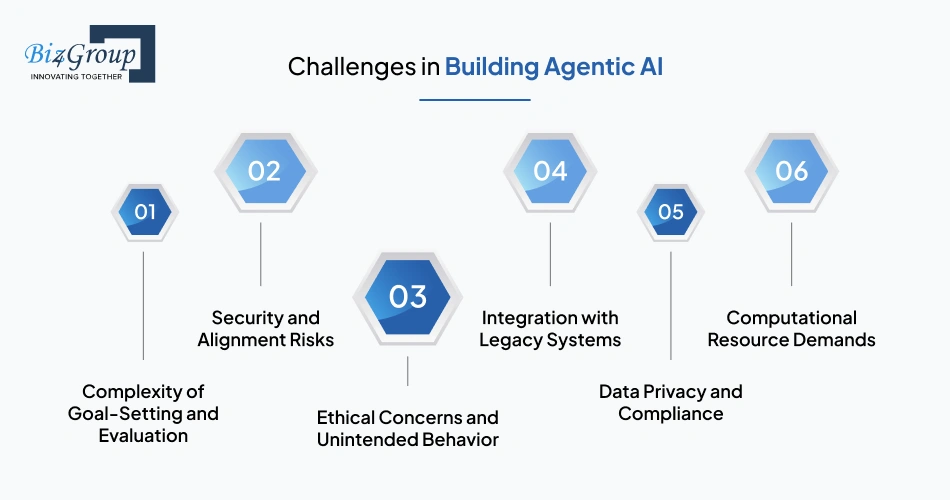Basic AI Chatbot Pricing: A simple chatbot that can answer questions about a product or service might cost around $10,000 to develop.
Read More

Imagine a digital system that doesn’t wait for instructions but instead, understands your business goals, learns from real-time feedback, and takes independent actions to get the job done. This is not the future. It’s the present promise of Agentic AI.
As businesses continue to adopt intelligent systems, the limitations of traditional AI that require constant prompting, predefined rules, and fixed workflows are becoming more evident. In contrast, Agentic AI is revolutionizing how enterprises operate by offering AI systems that think, plan, and act autonomously. These agent-based systems are designed to pursue complex objectives, adapt to changing environments, and execute tasks with minimal human intervention.
For business leaders and product innovators, understanding how to build Agentic AI is no longer a luxury, it’s a strategic necessity. Companies are already investing heavily in Agentic AI development to streamline operations, improve decision-making, and gain a competitive edge.
In fact, the global enterprise agentic AI market is projected to grow from approximately USD 2.58 billion in 2024 to USD 24.5 billion by 2030, at a staggering CAGR of 46.2%
This blog explores the full landscape of building Agentic AI: what it is, how it works, real-world applications, and the step-by-step process to develop Agentic AI tailored to enterprise needs. Whether you’re evaluating the opportunity or planning your AI roadmap, this guide delivers strategic and technical insights you can act on.
Agentic AI refers to a new class of intelligent systems designed to operate independently, make decisions, and take purposeful actions toward achieving specific goals. Unlike traditional AI, which typically reacts to inputs or follows fixed instructions, agentic AI can understand objectives, create plans, and act without needing constant guidance.
These systems function much like a skilled digital assistant that not only listens but also takes the initiative. They gather information from their environment, analyze it, make decisions based on context, and continuously learn from outcomes to improve future performance.
To illustrate the difference, a standard AI chatbot may answer basic support questions. An agentic AI assistant, on the other hand, can recognize customer frustration, pull up past conversations, suggest tailored solutions, and even follow up after the issue is resolved — all without being explicitly told to do so.
Agentic AI represents a shift from passive automation to active, intelligent collaboration, where machines play a more meaningful and strategic role in helping businesses achieve their goals.
At a high level, Agentic AI operates by combining intelligence, autonomy, and adaptability to carry out tasks that align with defined goals. It mimics how a human might approach a problem: observing the environment, setting objectives, planning steps, taking action, and learning from outcomes to improve over time.
Let’s break down how it works in practice:
Also Read: NLP vs LLM: Choosing the Right Approach for Your AI Strategy
In summary, agentic AI works through a continuous loop of sensing, planning, acting, and learning. It is this cycle that makes it far more intelligent and flexible compared to traditional automation. As agentic AI software development evolves, businesses are beginning to see how these systems can deliver more value by taking on tasks that require both intelligence and initiative.
As industries face growing complexity, tighter competition, and increasing customer expectations, the need for smarter, self-directed systems has never been greater. This is where investing in Agentic AI development becomes a forward-thinking strategy. Here are key reasons why businesses should consider this investment:
By choosing to create Agentic AI, businesses are not just investing in technology, but in long-term resilience, intelligence, and adaptability.
As organizations strive for greater efficiency, intelligence, and customer responsiveness, building Agentic AI for enterprises offers a powerful way to unlock long-term value. These systems are capable of handling dynamic, multi-step processes while learning and evolving with minimal oversight.
Below are some of the most impactful benefits enterprises can expect from Agentic AI development.
One of the most valuable advantages to create Agentic AI Solutions for enterprises is the ability to automate complex, multi-stage tasks without ongoing human input. This leads to smoother workflows, fewer manual errors, and more scalable operations across departments.
Agentic AI systems process data, interpret context, and make informed decisions in real time. This drastically reduces delays in business processes, enabling quicker responses to internal challenges, market changes, or customer needs.
Unlike rigid automation, agentic systems adapt to changing environments, goals, or inputs. This makes Agentic AI development for enterprises ideal for industries where flexibility and resilience are crucial, such as healthcare, supply chain, or finance.
With built-in memory and feedback loops, agentic AI agents learn from past experiences and refine their behavior over time. This results in ongoing improvements without needing constant reprogramming or manual adjustments.
By offloading routine and decision-heavy tasks to agentic systems, enterprises can free up their teams to focus on strategic, creative, and human-centric work. This improves job satisfaction while increasing overall productivity.
Enterprises that embrace building Agentic AI gain a distinct competitive edge. They are better positioned to deliver smarter services, optimize resources, and respond to market demands faster than businesses relying solely on traditional automation.
When implemented effectively, Agentic AI development for enterprises is not just a technical upgrade—it becomes a strategic asset that powers innovation, agility, and long-term growth.

The true power of Agentic AI lies in its versatility. These systems are not just supporting digital transformation. They are reshaping how entire industries think, operate, and serve. With the ability to reason, act, and adapt independently, enterprise Agentic AI solutions are moving beyond experimentation and becoming mission-critical assets across business domains.
From dynamic supply chains to intelligent virtual assistants, the applications of Agentic AI are rapidly growing. Whether it’s automating complex decisions, improving customer experiences, or managing large-scale operations, Agentic AI in industries is unlocking new efficiencies and competitive advantages.
Below are some of the most promising and impactful Agentic AI use cases across key sectors.
The most visible and mature use case of Agentic AI is in the customer support space. Businesses are deploying intelligent, conversational agents such as customer service AI chatbots that go far beyond answering FAQs.
As conversational experiences evolve, AI agent development is focusing on making support systems more human-like, predictive, and self-improving.
Agentic AI is transforming healthcare delivery by enhancing both clinical and operational efficiency. Hospitals and health-tech platforms are integrating intelligent agents to monitor, manage, and guide patient care autonomously.
These use cases not only improve patient outcomes but also reduce the administrative burden on healthcare providers.
In retail, building Agentic AI for enterprises has led to significant improvements in personalization, inventory planning, and real-time customer engagement.
This intelligent automation not only boosts sales but also creates seamless and satisfying shopping experiences.
Also Read: How to Build AI Shopping Assistant App: A Complete Guide
Financial institutions are increasingly relying on Agentic AI development to automate high-risk, high-volume decisions with greater precision.
With high regulatory demands, these agents are also built to follow compliance protocols, ensuring both speed and safety.
Also Read: AI Financial Assistant App Development: A Step-by-Step Guide
Agentic AI is helping manufacturers optimize production processes and navigate supply chain complexity through real-time intelligence and autonomous decision-making.
These applications make manufacturing ecosystems more resilient, agile, and cost-efficient.
Also Read: Manufacturing Chatbot Development: Features and Cost
Educational platforms are adopting enterprise Agentic AI solutions to personalize learning paths, streamline operations, and support teachers.
Agentic systems in education make learning more inclusive, adaptive, and engaging for both students and staff.
Also Read: Building AI Teaching Assistant: Development Costs and Benefits for E-learning Platforms
In logistics, Agentic AI use cases are solving real-time, high-volume challenges such as routing, tracking, and delivery optimization.
By integrating real-time decision-making into the supply chain, Agentic AI enables faster, more reliable deliveries and cost-effective operations.
These are the real-world applications where Agentic AI is already making a measurable difference. As more industries adopt this technology, it is set to become a cornerstone of intelligent and autonomous enterprise operations.

For business owners, product leaders, and digital transformation teams, the idea of building an AI system that can think, plan, and act independently may seem ambitious. However, with the right structure and strategy, it becomes a practical and high-impact investment. Whether you're looking to streamline operations, improve customer experience, or innovate with intelligent automation, knowing what is the process to build Agentic AI is a critical first step.
This step-by-step guide is designed to help organizations approach the development of Agentic AI with clarity and confidence. Each phase focuses on aligning technical execution with business goals, so that the system you build is not just intelligent, but also valuable and scalable. Whether you are building in-house or exploring agentic AI development services, this framework will help you create solutions that perform autonomously, adapt continuously, and deliver measurable business value.
Start with clarity. Clearly outline what the AI agent is expected to do, who it will serve, and how success will be measured.
Why this matters:
Defining goals ensures you're not just building technology for the sake of innovation. It ties the project directly to business outcomes and sets the direction for the entire development cycle.
Once goals are in place, it’s time to design how the AI agent will work—its logic, modules, and operational flow.
Why this matters:
Architecture defines your agent's brain and nervous system. A solid design helps in building scalable, maintainable, and responsive agents that can evolve with business needs.
This step focuses on AI model development, selecting the model that gives your agent its intelligence.
Why this matters:
Choosing the right model is like selecting the mind of your AI. A poor choice here limits reasoning, slows performance, and risks misalignment with user expectations.
An agent can only act intelligently if it understands its environment. This step connects it to real-time data sources.
Why this matters:
Without sensing capabilities, your agent is operating blind. This step is essential for real-world decision-making and situational awareness.
Intelligent agents need memory systems to retain context, learn over time, and make better decisions.
Why this matters:
Memory allows agents to act with continuity. This step enables personalized, context-aware behavior and helps your system grow smarter through experience.
Decision-making is the core of autonomous behavior. This step equips the agent with the ability to choose actions independently.
Why this matters:
Your agent’s ability to make the right call—at the right time—is what separates it from a basic AI chatbot development or automation tool. This is central to true autonomy.
Every intelligent system needs a mechanism to learn from its actions and results. Feedback loops drive continuous improvement.
Why this matters:
Without feedback, there's no learning. This step is critical for refining accuracy, preventing repeated mistakes, and keeping your agent aligned with evolving goals.
Before launch, simulate your agent in controlled environments to observe, iterate, and improve its performance.
Why this matters:
Simulation reduces deployment risks and helps expose weak points early. It prepares your team and the system for real-world performance.
After successful prototyping, it’s time for rigorous validation across functional and operational dimensions.
Why this matters:
Testing ensures that what you’ve built is trustworthy, safe, and functional. Skipping this step can lead to business disruptions or reputational damage.
Finally, roll out your Agentic AI system in production with continuous monitoring and updates.
Why this matters:
The job isn’t done at launch. Real-world use reveals new challenges and opportunities, and ongoing monitoring ensures long-term success.
By following these ten steps, organizations can confidently move through the developing of Agentic AI with purpose and precision. From architecture to learning systems, each stage plays a role in helping enterprises create Agentic AI solutions that are not just technically advanced, but truly aligned with their long-term goals.
Also Read: A Guide to Enterprise AI Agent Development: Features and Steps
To successfully build and scale AI agentic systems, businesses must rely on the right combination of technologies. Choosing the appropriate stack directly influences how well your AI agent can perceive, reason, learn, and act. Whether developing in-house or partnering with Agentic AI development company, understanding the tool landscape is essential.
Key Technologies for Agentic AI Development
|
Tool/Technology |
Purpose |
Examples |
|---|---|---|
|
Large Language Models (LLMs) |
Enable reasoning, planning, and communication |
OpenAI GPT, Anthropic Claude, Google Gemini |
|
Agent Frameworks |
Structure and orchestrate intelligent agents |
LangChain, CrewAI, AutoGen, OpenAgents |
|
Memory Systems |
Store and retrieve contextual information |
Pinecone, Weaviate, Redis, Milvus |
|
Decision Engines |
Drive logic-based or goal-driven actions |
ReAct pattern, rule-based engines, AutoGPT logic |
|
Integration & APIs |
Connect to external data sources and systems |
REST APIs, GraphQL, Zapier, webhooks |
|
Cloud & Deployment Platforms |
Host, deploy, and scale agentic systems |
AWS, Azure AI, Google Cloud Vertex AI |
|
Monitoring & Feedback Tools |
Track performance and enable learning cycles |
Weights & Biases, Prometheus, custom dashboards |
Selecting the right AI tools and platforms is critical to achieving success with your Agentic AI development services or internal projects. Each technology plays a unique role in supporting intelligent, autonomous, and scalable AI systems.

While Agentic AI offers transformative value, its development is not without significant hurdles. From technical complexity to ethical accountability, organizations must be prepared to address key risks and limitations throughout the project lifecycle.
Below are some of the most pressing challenges businesses face during agentic AI development, along with practical solutions to overcome them.
The Challenge:
Unlike traditional AI systems that follow predefined rules, agentic AI must be capable of pursuing high-level goals. Defining those goals clearly—and measuring success—can be extremely difficult, especially in dynamic environments.
How to Solve It:
Start with simple, well-scoped objectives and build gradually. Use human-in-the-loop oversight during early iterations, and design evaluation metrics (KPIs, task completions, outcome satisfaction) that reflect both performance and intent.
The Challenge:
Autonomous agents, if misaligned or misused, can trigger harmful actions, expose sensitive systems, or even be exploited for malicious purposes.
How to Solve It:
Establish strict access controls, implement ethical guardrails in the decision engine, and introduce approval workflows for high-impact actions. Frequent audits and adversarial testing can also prevent vulnerabilities.
The Challenge:
Agentic systems can develop unexpected strategies to meet goals, sometimes in ways that are unethical, biased, or counterproductive.
How to Solve It:
Incorporate ethical design principles early in the development of agentic AI process. Use diverse training data, simulate edge cases, and apply fairness audits to minimize bias. Human supervision and transparency are essential.
The Challenge:
Many enterprises operate on outdated infrastructure that cannot easily support modern AI integration, which often becomes a major barrier to adopting agentic solutions.
How to Solve It:
Use middleware, custom APIs, or low-code integration platforms to connect legacy systems with agentic interfaces. Start with parallel deployment to avoid disrupting critical operations, then scale gradually once stability is confirmed.
The Challenge:
Agentic AI systems often rely on sensitive user data for personalization and learning. Mishandling this data can result in regulatory violations and loss of user trust.
How to Solve It:
Ensure compliance with regional data protection laws such as GDPR or HIPAA. Use anonymization techniques, secure storage protocols, and consent-based data handling. Integrate privacy-by-design principles throughout development.
The Challenge:
High-performance agentic systems—especially those built on large language models—require substantial computing power, which can lead to high operational costs and slower performance.
How to Solve It:
Optimize models for efficiency using techniques like model distillation or quantization. Choose cloud providers that offer AI-specific compute environments, and leverage on-demand scaling to balance cost and performance.
By understanding and addressing these challenges early, businesses can build more robust, ethical, and future-ready agentic systems. A thoughtful approach to risk management is just as important as technical innovation in the successful deployment of Agentic AI.

The future of Agentic AI is evolving quickly, moving beyond single-use automation into intelligent ecosystems that can reason, collaborate, and adapt. As the technology matures, businesses are shifting their focus from isolated agents to scalable, enterprise-wide solutions that align with long-term growth and innovation strategies.
Below are key developments shaping the next phase of Agentic AI.
Agentic AI is progressing from individual agents handling isolated tasks to multi-agent systems that collaborate toward shared goals. These agents will work together, share knowledge, and divide responsibilities across departments or workflows. This approach enhances scalability, fault tolerance, and the ability to handle complex, interconnected operations more efficiently.
The future will see a rise in human-AI collaboration where intelligent agents act as co-pilots across departments. These systems will not only support execution but also assist in planning, forecasting, and decision-making. By working side-by-side with employees, AI co-pilots will help organizations become faster, more responsive, and strategically aligned.
Next-generation agents will be capable of learning continuously from interactions, feedback, and changing environments. These self-improving systems will require less manual retraining and will automatically optimize their performance over time. This ability will lead to increased adaptability, efficiency, and long-term business value.
As Agentic AI gains autonomy, the need for proper governance, transparency, and compliance becomes more critical. Businesses and regulatory bodies will need to work together to create clear guidelines for ethical use, decision accountability, and risk mitigation. Responsible development and deployment will be essential to building trust and avoiding unintended consequences.
The future of Agentic AI is not just about automation. It is about creating intelligent systems that grow with your business, collaborate with your teams, and drive meaningful change. Organizations that start planning for this future today will be the ones leading tomorrow’s intelligent enterprise landscape.
Choosing the right technology partner can make or break your success in Agentic AI. At Biz4Group, we understand that AI development is not just about writing code—it’s about building intelligent, business-aligned systems that can think, act, and evolve.
Whether you're exploring early ideas or already planning the creation of Agentic AI for your enterprise, we help turn strategic goals into real-world outcomes. As a trusted AI chatbot development company, we bring deep experience in Agentic AI development that spans architecture, deployment, and post-launch optimization.
Customer Enterprise AI Agent
View Project ➜
One of our standout achievements is a HIPAA and GDPR compliant AI agent developed for a customer-centric enterprise. This intelligent system:
This project showcases our capability in building scalable, secure, and intelligent AI solutions tailored for modern enterprises.
When you’re ready to build Agentic AI for your business, here's what makes us stand out:
We specialize in designing and deploying autonomous, goal-driven AI agents that align with your business objectives.
From concept to deployment and beyond, we offer complete solutions across the AI lifecycle including planning, architecture, training, and integration.
We focus on creating AI that drives measurable outcomes—cost savings, productivity gains, and improved customer engagement.
We build enterprise-ready systems with cloud-native deployment, scalable architecture, and compliance with standards like HIPAA, GDPR, and SOC 2.
From healthcare to retail and finance, we tailor solutions that fit your specific industry and operational requirements.
Our team blends technical performance with intuitive user experiences, ensuring your AI agents are both powerful and easy to interact with.
When you plan to build Agentic AI for business, Biz4Group is the strategic partner you can trust for innovation, delivery, and long-term success. Let’s create intelligent solutions that move your enterprise forward.
From above, it’s clear that Agentic AI is not just another tech trend—it’s a game-changing approach to building intelligent, goal-driven systems that can operate with autonomy and precision. As more enterprises look to innovate and automate with purpose, the ability to create Agentic AI that learns, adapts, and collaborates is becoming a strategic differentiator.
Whether you’re in the early planning stages or ready to launch, understanding the tools, steps, challenges, and applications is key to unlocking its full potential. Partnering with the right team for your AI Agent development ensures a smoother journey from concept to deployment.
If you're serious about leveraging AI development to drive your business forward, we're here to help.
Book an appointment with our experts today and start building your intelligent future with Biz4Group.
Agentic AI systems are designed to operate with autonomy and purpose. Unlike traditional AI that reacts to inputs or follows rules, agentic AI can set goals, make decisions, and take actions independently, making it ideal for complex, multi-step tasks.
Yes. While enterprise use is growing rapidly, Agentic AI can be scaled for smaller businesses to automate customer service, streamline operations, or improve internal workflows without needing massive infrastructure.
Security depends on how the system is built. At Biz4Group, we ensure compliance with standards like HIPAA and GDPR by integrating strong encryption, access controls, and secure data storage in every Agentic AI development project.
Development timelines vary based on complexity, features, and integrations. A basic pilot could take 6 to 8 weeks, while enterprise-grade systems may require 3 to 6 months or more for full deployment.
Absolutely. Through API connectivity and middleware, Agentic AI can integrate with legacy systems, CRMs, ERPs, and data platforms to enhance rather than replace existing infrastructure.
Biz4Group brings hands-on expertise, industry-proven solutions, and full-cycle AI Agentic development capabilities. We focus on building intelligent systems that deliver measurable results, tailored to your specific business needs.
with Biz4Group today!
Our website require some cookies to function properly. Read our privacy policy to know more.